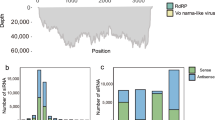Abstract
A very low incidence (<0.01%) of a blue iridovirus (IV) was found in larvae of the Japanese beetle,Popillia japonica Newman, that were sampled over a two year period on Terceira Island (Azores, Portugal). In the most heavily infected larvae, a deep blue iridescence was observed, particularly in the fat body. Transmission electron microscopy revealed the characteristic crystalline arrays of the hexagonal virus particles in the cytoplasm of fat body cells, tracheal matrix, muscle, hypodermis and blood cells. Crystals of the virus particles were also observed freely circulating in the hemolymph. The average diameter of negatively stained purified virus particles was 157 nm. Similarities and differences with other IVs found in the Scarabaeidae are discussed. Considering the broad host range of some of the iridescent viruses, the relatively recent invasion of Terceira byP. japonica, and the rarity of the virus in the beetle, it is probable that the infection was the result of transmission from another species of soil-inhabiting arthropod. Its value as a potential biological control agent ofP. japonica is negligible.
Résumé
La présence très faible (<0.01%) d'un iridovirus bleu a été détectée dans les larves du ScarabéidePopillia japonica Newman, qui ont été prélevées au cours d'une période de deux années sur l'île de Terceira (Açores, Portugal). Chez les larves les plus fortement infestées, une iridescence d'un bleu profond était observée, particulièrement dans le corps gras. La microscopie électronique à transmission a permis de déceler les alignements cristallins caractéristiques formés par les particules hexagonales du virus dans le cytoplasme des cellules du corps gras, des trachées, des muscles, de l'hypoderme et des cellules sanguines. Les cristaux des particules de virus ont aussi été observés circulant librement dans l'hémolymphe. Le diamètre moyen des virus purifiés en coloration négative était de 157 nm. Les ressemblances et les différences avec d'autres iridovirus trouvés chez les Scarabaéidés sont discutées. Si l'on considère la vaste gamme d'hôtes de certains iridovirus, l'invasion relativement récente de Terceira parP. japonica, et la rareté du virus chez cet insecte, il est probable que l'infection résulte de la transmission à partir d'une autre espèce d'arthropodes vivant dans le sol. Son intérêt en tant qu'agent potentiel de lutte biologique contreP. japonica semble négligeable.
Similar content being viewed by others
References
Adams, J. R. &Bonami, J. R. — 1991. Preparation of invertebrate viruses and tissues for examination.In: Atlas of Invertebrate Viruses. (Adams, J. R. &J. R. Bonami [eds.])— pp. 9–40 and appendix p. 671.CRC Press, Boca Raton, FL.
Anthony, D. W. &Comps, M. — 1991. Iridoviridae.In: Atlas of Invertebrate Viruses. (J. R. Adams &J. R. Bonami [eds.])— pp. 55–86. CRC Press, Boca Raton, FL.
Carey, G. P., Lescott, T., Robertson, J. S., Spencer, L. K. &Kelly, D. C. —1978. Three African isolates of small iridescent viruses: Type 21 fromHeliothis armigera (Lepidoptera: Noctuidae), Type 23 fromHeteronychus arator (Coleoptera: Scarabaeidae), and Type 28 fromLethocerus columbiae (Hemiptera heteroptera: Belostomatidae). —Virol., 85: 307–309.
Day, M. F. &Mercer, E. H. — 1964. Properties of an iridescent virus from the beetle,Sericesthis pruinosa. —Aust. J. Biol. Sci., 17, 892–902.
Elliott, R. M., Lescott, T. &Kelly, D. C. — 1977. Serological relationships of an iridescent virus (Type 25) recently isolated fromTipula sp. with two other iridescent viruses (Types 2 and 22). —Virol., 81, 309–316.
Federici, B. A. — 1980. Isolation of an Iridovirus from two terrestrial isopods, the pill bug,Armadillidium vulgare, and the sow bug,Porcellio dilatus. —J. Invertebr. Pathol., 36, 373–381.
Glare, T. R. &Crawford, A. M. — 1992. Viral diseases of scarabs.In: Use of Pathogens in Scarab Pest Management. (T. R. Glare &T. A. Jackson [eds.]) — pp. 21–32.Intercept, Andover, Hampshire. 298 pp.
Glitz, D. G., Hills, G. J. &Rivers, C. F. — 1968. A comparison of theTipula andSericesthis iridescent viruses. —J. Gen. Virol., 3, 209–220.
Hall, D. W. — 1985. Pathobiology of invertebrate icosahedral cytoplasmic deoxyriboviruses (Iridoviridae).In: Viral Insecticides for Biological Control. (K. Maramorosch &K. E. Sherman [eds.]) — pp. 163–196.Academic Press, New York.
Kalmakoff, J., Moore, S. &Pottinger, R. D. — 1972. An iridescent virus from the grass grubCostelytra zealandica: serological study. —J. Invertebr. Pathol., 20, 70–76.
Longworth, J. F., Scotti, P. D. &Archibald, R. D. — 1979. An iridovirus from the black bettle,Heteronychus arator (Coleoptera: Scarabaeidae). —New Zealand J. Zool., 6, 637–639.
Martignoni, M. E. &Iwai, P. J. — 1981. A catalogue of viral diseases of insects, mites and ticks.In: Microbial Control of Pests and Plant Diseases 1970–1980. (H. D. Burges (ed.)). pp. 897–911. —Academic Press, London.
Moore, S. G., Kalmakoff, J. &Miles, J. A. R. — 1974. An iridescent virus and a rickettsia from the grass grubCostelytra zealandica (Coleoptera: Scarabaeidae). —New Zealand J. Zool., 1, 205–210.
Ohba, M. &Aizawa, K. — 1979. Multiplication ofChilo iridescent virus in noninsect arthropods. —J. Invertebr. Pathol., 33, 278–283.
Poprawski, T. J. &Yule, W. N. — 1990. A new small iridescent virus from grubs ofPhyllophaga anxia (Le Conte) (Col., Scarabaeidae). —J. Appl. Entomol., 110, 63–67.
Smith, K. M., Hills, G. J. &Rivers, C. F. — 1961. Studies on the cross-inoculation of theTipula iridescent virus. —Virol., 13, 233–241.
Steinhaus, E. A. &Leutenegger, R. — 1963. Icosahedral virus from a scarab (Sericesthis). —J. Insect Pathol., 5, 266–270.
Author information
Authors and Affiliations
Rights and permissions
About this article
Cite this article
Lacey, L.A., Adams, J.R. An iridescent virus fromPopillia japonica (Col.: Scarabaeidae) . Entomophaga 39, 131–136 (1994). https://doi.org/10.1007/BF02372351
Received:
Accepted:
Issue Date:
DOI: https://doi.org/10.1007/BF02372351




